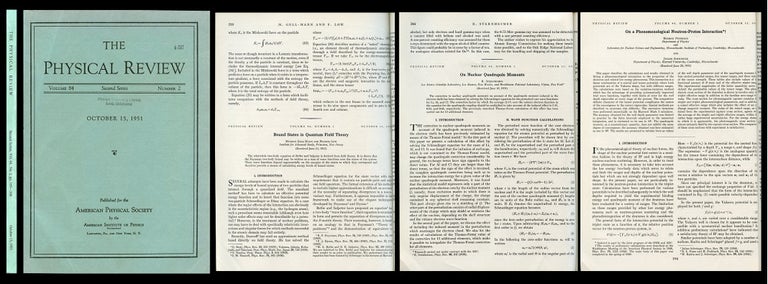Bound States in Quantum Field Theory (Gell-Mann, pp. 350-355) WITH On Nuclear Quadrupole Moments (Sternheimer, pp. 244-254) WITH On a Phenomenological Neutron-Proton Interaction (Schwinger, pp. 194-204) in Physical Review 84, Number 2, 15 October 1951
Lancaster: American Physical Society, 1951. 1st Edition. FIRST EDITION IN ORIGINAL WRAPS OF 3 SIGNIFICANT PAPERS: GELL-MANN & LOW’S THEOREM, STERNHEIMER ON SHIELDING & ANTI-SHIELDING, & SCHWINGER ON PHENOMENOLOGICAL NEUTRON-PROTON INTERACTION.
GELL-MANN & LOW: Tackling formalism and the bound-state problem, Gell-Mann and Low’s paper is Nobel Prize winner Gell-Mann’s first published paper. The theorem and formal derivation they achieve is a “cornerstone in quantum field theory and zero-temperature many-body theory” (Molinari, Journal of Mathematics, 48, 2007). In quantum field theory, the Gell-Mann and Low theorem “allows one to relate the ground (or vacuum) state of an interacting system to the ground state of the corresponding non-interacting theory. The theorem is useful because, among other things, by relating the ground state of the interacting theory to its non-interacting ground state, it allows one to express Green’s functions (which are defined as expectation values of Heisenberg-picture fields in the interacting vacuum) as expectation values of interaction picture fields in the non-interacting vacuum. While typically applied to the ground state, the Gell-Mann and Low theorem applies to any eigenstate of the Hamiltonian. Its proof relies on the concept of starting with a non-interacting Hamiltonian and adiabatically switching on the interactions”; the proof is based on Dyson’s time-ordered expansion of the propagator; a proof based on exact identities for the time propagator is here given” (Wikipedia; Molinari).
STERNHEIMER: Physicists knew that electrons of any given ion interacted with the quadrupolar field of the nucleus as well as with the local electrostatic potential. With respect to NMR issues, though, an important question remained: “What part of the energy of the system ion plus nuclear quadrupole moment plus local field depends on the orientation of the nucleus?” (Solid State Physics, 5, 347). Sternheimer was the first to study questions of this nature.
Sternheimer found that “a perturbing potential, whether originating within an ion or outside it, polarizes the spherically symmetric complete shells of electrons. The complete shells, having thus lost their spherical symmetry, contribute destructively (shielding) or constructively (antishielding) to the perturbing potential at any site. The reduction or enhancement of the perturbing potential, the so called Sternheimer effect, could be accounted for in terms of some parameters” (Dekeyser, Electron Emission Spectroscopy, 250).
To this day, the two Sternheimer shielding factors are still taken into account when core electrons are near an electric field gradient, Sternheimer shielding and anti-shielding factors. One is “associated with charges which are on the atom (or ion) in question, and one associated with more distant charges” (Vij, Handbook, 92).
SCHWINGER & FESHBACH: “This paper describes the calculations and results obtained in fitting a phenomenological interaction to the properties of the deuteron and related low energy phenomena” (Schwinger and Feshbach, Phys. Rev. 84, 194). Together, Schwinger and Feshbach “solved the problem of the deuteron ground state and numerically calculated the quadrupole moment, effective range and relative probabilities for the system remaining in a D-angular momentum state, as well as the cross sections for photoelectric disintegration of deuterons” (Mehra, Climbing the Mountain, 163). While their calculations are now mainly of “historical interest only”, Schwinger and Feshbach made their calculations on Harvard’s first ‘computing machine’ – an IBM Automatic Sequence Controlled Calculator/Mark I; as well, they were among the first to use it (ibid). That machine is now on display in Harvard’s Science Center. Item #906
CONDITION & DETAILS: Lancaster: American Physical Society. Original wraps, complete. Two nearly invisible stamp on front wrap; professionally rebacked at the spine. 4to (10.5 x 8 inches; 263 x 200mm). Near fine condition inside and out.
Price: $300.00

